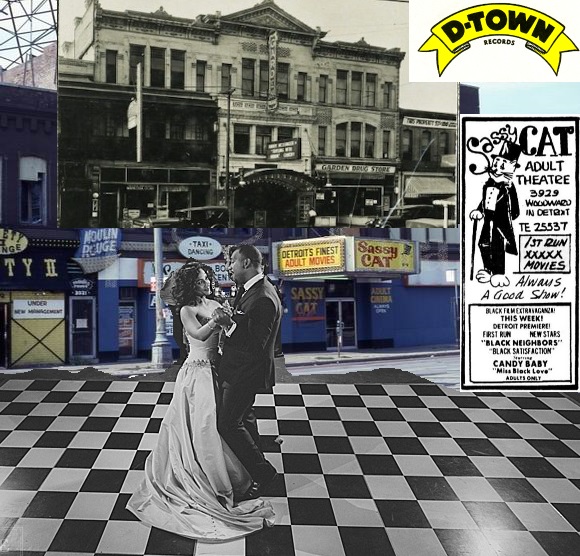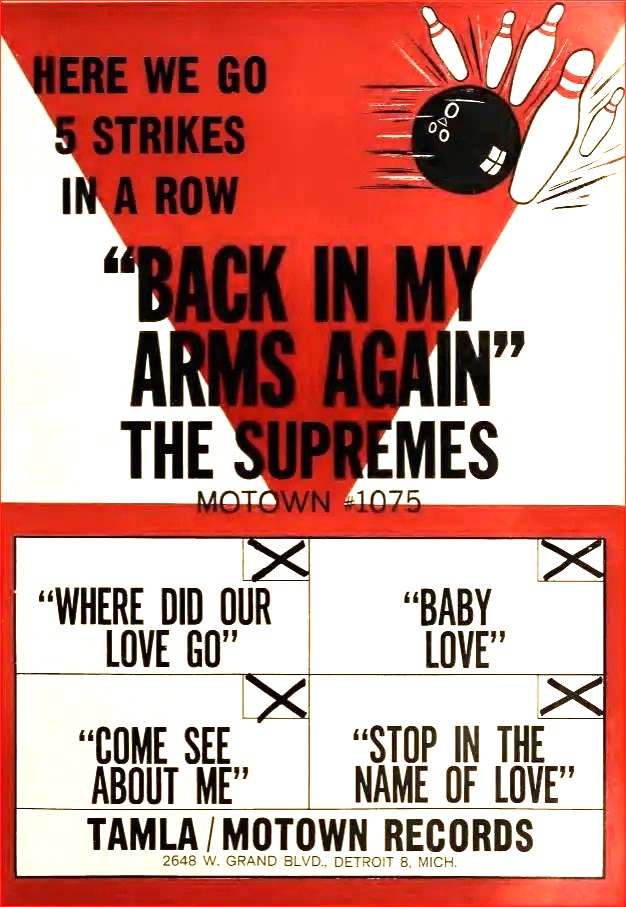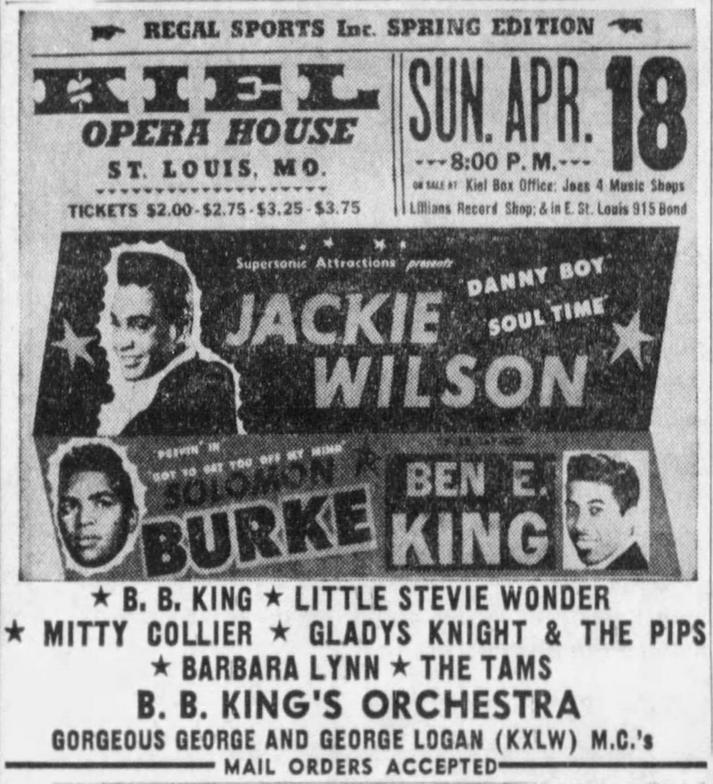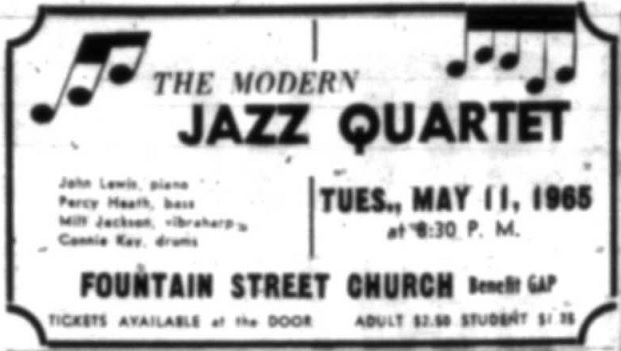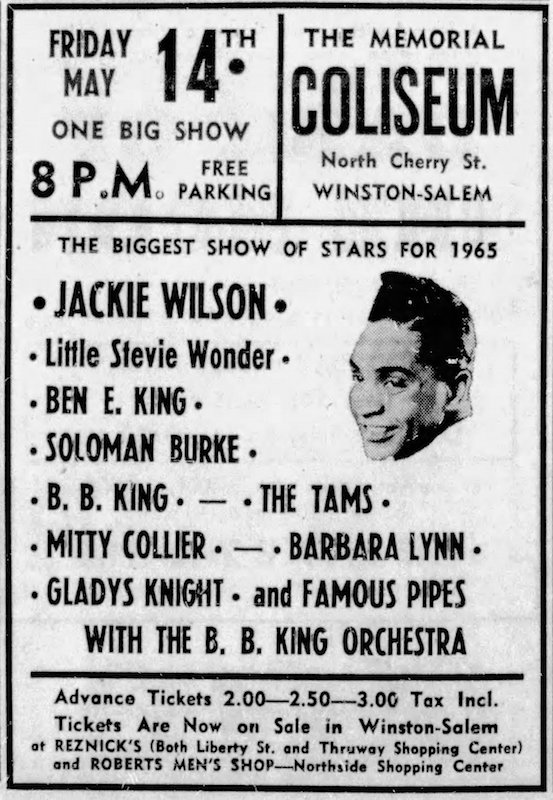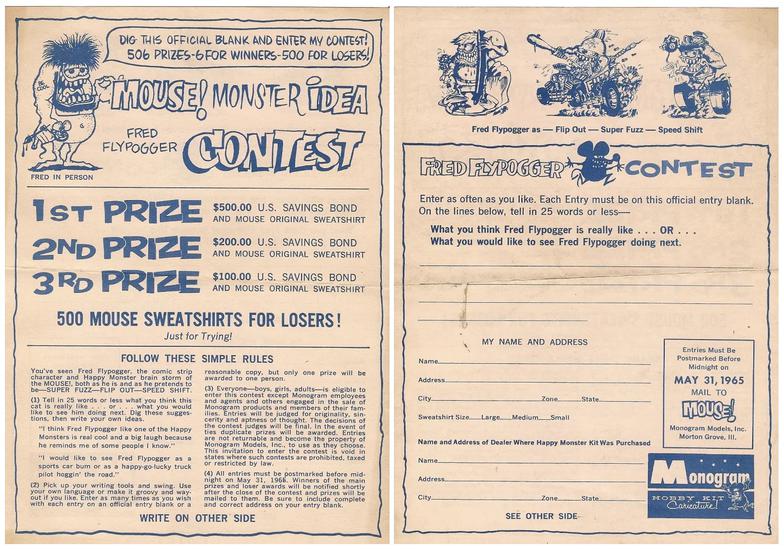Splatt Gallery
Double click here to add text.
Splatt Gallery's History of Michigan Music Posters
Volume Two - 1964-1966 - Page Six
***********************************************************
Volume Two - 1964-1966 - continues - HERE
Newspaper ads for the touring Shindig! Show at Cobo Arena in Detroit, Michigan, May 2, 1965, and at the Civic Center in Lansing, Michigan on the following day, May 3, 1965.
Poster for Dick Clark’s Spring ’65 Caravan of Stars show at the Wichita Lawrence Stadium in Wichita, Kansas on May 4, 1965, with Michigan artists Del Shannon and The Velvelettes.
The Velvelettes – He Was Really Saying Something (1964)
https://www.youtube.com/watch?v=bCnGFtS4iC4
A pair of ABC-Paramount Records ads for the Soupy Sales album “Soupy Sales Sez Do The Mouse! And Other Teen Hits”, released on April 24, 1965.
Born Milton Supman, Sales began his television career in Cincinnati, Ohio with “Soupy’s Soda Shop” in 1950, TV’s first teen dance program, two years before “American Bandstand”. He moved to Detroit in 1953, and over the next seven years he was the Motor City’s top TV personality, with “Lunch with Soupy Sales” on Saturdays and weekday mornings, a dinner-time show, and a late night jazz music show called “Soupy’s On”. For a while, his total on-air time was a whopping 11 hours per week.
He took the show to Los Angeles, California in 1960, and then to New York City in 1964, with the peak of his popularity in 1965-1966. On New Year’s Day 1965, miffed that he had to work on the holiday, Sales infamously told the kids watching the show to go into their parent’s room and take “the green pieces of paper” with pictures of the Presidents or “funny guys with wigs and beards” out of their wallets and “put them in an envelope and mail them to me”. The show was aired live and no tape of it exists, so a verbatim transcript of what Sales actually said is unknown, but the fast and furious calls from outraged parents earned him a two-week suspension. Thousands of envelopes containing cash arrived at the studio, some of it Sales reported was play money, it was all donated to charities.
Sales wrapped up his television career with seven years as a celebrity panelist on game shows such as “What’s My Line” and “Hollywood Squares” from 1968 through 1975.
Sales’ pal Frank Sinatra signed him to a recording contract on Sinatra’s Reprise Records label, which released two albums. He also released two albums on ABC-Paramount and the novelty dance single “The Mouse”. Then, completely inexplicitly, he was signed to Motown Records for the 1969 album “A Bag of Soup” which had Sales crooning current hits and a parody of “MacArthur Park”, called “Muck-Arty Park”. It’s all terribly, terribly awful.
The late-night jazz show that he had in Detroit, however, featured top jazz musicians that would stop by after performing at many of the twenty-four jazz clubs that were in the city at the time. Miles Davis made at least six appearances on the show, and we know that Miles didn’t suffer no fools, so Soup had to have been pretty cool.
The only known film footage of trumpeter Clifford Brown came from Sales’ show and it was used by Ken Burns in his “Jazz” documentary. Brown tragically died in a car crash on June 26, 1956 at age 25, just two weeks after his band, which featured drummer Max Roach and saxophonist Sonny Rollins, had performed a six-night stand at the Rouge Lounge in River Rouge, Michigan.
There is one more Soupy Sales connection to our story, his two sons, Tony and Hunt became rock musicians on bass and drums, and will later turn up in bands with Iggy Pop and David Bowie.
Clifford Brown – Soupy’s On TV Show (circa 1954-1956) - https://www.youtube.com/watch?v=9iuP3CfFZDQ
Poster/ad for Al Hirt in Lansing, Michigan on April 28, 1965.
In the history of 3929 Woodward Avenue, during the period in between the time when the 509 jazz club took over the stately Garden Theater, and the time that it became the Sassy Cat adult film theater, it was known as ”The Village”.
The atmosphere at The Village was R&B mixed with Beatnik. The stage show was Vaudevillian with dozens of acts rotating through on any given night, backed-up by moonlighting session players from around town and new bands happy to find a place to audition. One of the most popular groups at The Village was The Fabulous Peps, three energetic singers who incorporated wild stage moves, back-flips, and even some comedy into their act.
A young white kid with an incredibly soulful voice, named Billy Levise, started hanging out at the Village and became a member of the Peps. Eventually, Billy decided to go solo, changed his name to Billy Lee and joined up with a band that played at The Village called The Rivieras, consisting of Jim McCarty (guitar), Earl Elliott (bass), and Johnny "Bee" Badanjek (drums). A little less than a year later brought another change of name, from Billy Lee & The Rivieras to Mitch Ryder & The Detroit Wheels.
The Fabulous Peps in the meantime started recording for D-Town Records, run by Mike Hanks. Hanks, who left his job at the Ford factory in 1963 to try his luck in the record business, held a bitter grudge against Berry Gordy that was only exasperated when he tried to buy a house next door to Hitsville and got blocked out on the purchase. His "D-Town" label, and his subsequent "Wheelsville USA" label and "Wheelsville Revue" shows, were clearly a dig at Gordy.
The Peps – Detroit, Michigan (1965)
https://www.youtube.com/watch?v=kqTaKJrP1-I
An ad for Jackie Wilson, with Little Stevie Wonder and pre-Motown Gladys Knight & the Pips in Atlanta, Georgia on April 29, 1965.
An ad for Jackie Wilson and Little Stevie Wonder in Richmond, Virginia on April 25, 1965.
Motown Records ad in the April 24, 1965 issue of Cash Box magazine, predicting that the new single by The Supremes, “Back in My Arms Again”, would be their fifth in a row to hit #1.
A poster by Posters Inc of Philadelphia for a “Spectacular Stars of ‘65” show in Louisville, Kentucky on April 17, 1965, headlined by Detroit’s Jackie Wilson, and with Motown represented by Stevie Wonder.
Gladys Knight & the Pips were not yet with Motown, they would join the label in 1966. “Stop and Get A Hold of Myself” was one of their last pre-Motown singles, it has a good Northern Soul feel.
Gladys Knight & the Pips - Stop and Get A Hold of Myself (1965) - https://www.youtube.com/watch?v=aKpyrf1q84g
Poster and newspaper ad for Murray the K’s annual Easter Show in Brooklyn, New York, April 17-25, 1965. A Motown Revue, even though not labeled as such, with Marvin Gaye, the Miracles, Martha & the Vandellas, the Temptations, the Four Tops, and the Marvelettes.
A full-page ad and half-page bio of Stanley Mouse in the Spring 1965 edition of the Souvenir Program of the International Championship Auto Shows.
A poster by Posters Inc of Philadelphia for a “Spectacular Stars of ‘65” show in Charleston, South Carolina on April 21, 1965, headlined by Detroit’s Jackie Wilson, and with Motown represented by Stevie Wonder.
Motown Records ad in the April 24, 1965 issue of Billboard magazine, predicting that the new single by The Supremes, “Back in My Arms Again”, would be their fifth in a row to hit #1 on the Hot 100 chart, it was proven correct when the song made that mark for the first two weeks in June.
An ad for Buffy Sainte-Marie at Masonic Auditorium in Detroit on April 24, 1965, her second Michigan appearance. She would return for six nights at the Chess Mate club in October.
An ad for Palisades Park in New Jersey with John Lee Hooker appearing on April 21, 1965, “courtesy of Gerdes” as he was taking a mid-engagement break from his eleven nights at Gerdes Folk City in NYC.
Nice picture of Stevie Wonder from an April 19, 1965 “Show of Stars” program.
An ad for Jackie Wilson, with Little Stevie Wonder and pre-Motown Gladys Knight & the Pips at the Kiel Opera House in St. Louis, Missouri on April 18, 1965.
A Motown Records ad in the April 17, 1965 issue of Cash Box magazine for the single “When I’m Gone” by Brenda Holloway.
Newspaper ad for the Grand Opening of “Detroit’s Newest Supper Club”, the Charade in Detroit, Michigan on April 17, 1965. Among the performers was Maynard Ferguson in the peak of his acid years, he had moved his family to the Hitchcock Estate in Millbrook, New York in November 1963 to live with Timothy Leary, Ram Dass, and their community from Harvard University. He and his wife Flo used LSD, psilocybin and other psychedelic drugs. They lived at Millbrook for about three years, playing clubs and recording several albums.
A poster for the Soupy Sales Easter In Person Show at the Paramount Theater in Manhattan, NYC on April 16, 1965. Notable about this show is that an unknown Jimi Hendrix appeared onstage as part of Little Richard’s band. You can read all about it here:
https://bestclassicbands.com/soupy-sales-easter-show-1965-4-16-177/
We wanted to present the following video of Sales hosting a Hullabaloo show almost exactly a year later, where he proudly presents the band Tony and the Tigers that included his two sons, Tony and Hunt.
The gnarly pirate-looking gentleman shown above is Hunt Sales in 2019, living in Austin, Texas. “The drummer received no writing credit for his iconic beat on the title track of Iggy Pop’s “Lust For Life” album – one of the most recognizable drum parts of the last 50 years.” That story is better told here:
https://www.austinchronicle.com/music/2019-01-25/storied-austin-drummer-hunt-sales-gets-his-shit-together/
Soupy Sales – Hullabaloo TV Show (April 4, 1966)
https://www.youtube.com/watch?v=wVqxSd6EfIg
Poster from the SDS in Ann Arbor, Michigan for a protest march in Washington, DC, April 17, 1965.
The bottom strip ad on the front cover of the May 6, 1965 issue of Billboard magazine with Aretha Franklin’s single “Respect” and 10th studio album “I Never Loved A Man The Way I Love You”.
On May 7, 1965, Dave Leone celebrated the one-year anniversary of his Hideout Club in Harper Woods, Michigan, and two weeks later he opened Hideout #2 in Southfield, putting his partner Punch Andrews in charge of the new location. The anniversary show "formally introducing two of the toughest groups that ever arrived", Steve Lymon & the Ravens plus "that down home five", the Pleasure Seekers. The club also boasted their "thousand dollar sound" PA system.
Things were going so well that shortly after the club’s first year anniversary in May 1965, Leone found a second location, a Knights of Columbus Hall in Southfield, Michigan, called it Hideout #2 and put his friend, Punch Andrews in charge of it. The Fugitives moved over to the new location and another band, The Underdogs, began playing the original spot.
Dissatisfied with the D-Town label’s handling of The Fugitives’ record, Leone decided to start his own label, called Hideout Records. For his first release he wanted to make an album as a “thank you” to the Hideout patrons. Recording a set by The Fugitives at the Quackenbush brothers’ home and adding crowd noise and applause on a second track, he made 300 copies of the “live” album, “The Fugitives at Dave’s Hideout” and sold them at the club for $3 each, selling out immediately. It may be the very first album of what would later be labeled “garage rock”, it certainly was the first in the Detroit area.
For the label’s first single, Leone released The Underdogs’ song “Man In A Glass”. The single was just starting to get some traction when it was discovered that although the band claimed to have written the lyrics for the song, they were actually taken, pretty much verbatim, from the pledge used at Alcoholics Anonymous. The single was immediately pulled from distribution.
The Underdogs – Friday Night at The Hideout (1965)
https://www.youtube.com/watch?v=JoTTWLm6Eos
Similar to the “Live at the Hideout” album that the Hideout club produced for its fans, The Cage –A-Go-Go, that operated out of the back of the Detroit Musician’s Union Hall compiled an album of house favorites, The Fugitives (future SRC), The Lourds (future Amboy Dukes), and The Oxford Five (no future) and pressed a few hundred copies for the club goers. The album was re-released a short time later as “Long Hot Summer” on the Hide the Sausage label.
The unfortunate Oxford Five may have the best song on the album with “The World I’ve Planned” which seems to be their sole recording, somewhat confusingly on this compilation that was supposedly released in 1965, while the single proper was released on Sidra Records in 1967.
The Oxford Five – The World I’ve Planned (1967)
https://www.youtube.com/watch?v=DKjHXrUStLU
In 2001, Norton Records released a compilation called “Friday at the Hideout – Boss Detroit Garage 1964-67” with 18 tracks by artists that had released singles on the Hideout label, including the Underdogs, Pleasure Seekers, Doug Brown & the Omens, Four Of Us, the Henchmen, the Mushrooms, T.R. & the Yardsmen, and the Fugitives.
An ad for the package tour with Jackie Wilson back in the headlining slot in Nashville, Tennessee on May 9, 1965, also featuring Little Stevie Wonder and the pre-Motown Gladys Knight & the Pips.
“The World We’ve Planned” by the Oxford 5 is a favorite track among compilers of archival obscure Sixties rock and is included on all six of such albums shown above.
The Motor Town Revue came to Lansing, Michigan on May 9, 1965, featuring Marvin Gaye, the Marvelettes, the Four Tops, Martha & the Vandellas, the Contours, Kim Weston, Willie Tyler & Lester, Choker Campbell, and the Spinners.
An ad for Sammy Davis at Masonic Temple in Detroit, Michigan on May 9, 1965. It was Davis’ (not yet Jr.) first Michigan appearance in eight years and the concert was a benefit for the America Conscience Fund, a US Department of the Treasury program that collects voluntary contributions from people who have stolen from or defrauded the United States Government.
An ad for the Modern Jazz Quartet, featuring Detroit vibraphonist Milt Jackson, at the Fountain Street Church in Grand Rapids, Michigan on May 11, 1965.
An ad for the Penny Farthing in Toronto, Ontario, Canada with Chuck Mitchell from Detroit appearing for five nights, April 27, 1965 through May 1st. This is where and when Chuck met Joni.
The day after the Quatro sisters, Suzi and Patti, of Gross Pointe, Michigan saw The Beatles on the Ed Sullivan show, they started a band. They recruited a third sister, Arlene, along with The Ball sisters, Nancy and Mary-Lou and called themselves The Pleasure Seekers.
Although she was only fourteen, Suzi started hanging out at The Hideout and Dave Leone gave her a job selling Cokes at the bar. One night, during a Battle of the Bands show, Suzi told Dave that her band was better than any of those playing and so he helped them get some equipment and put them on stage. They premiered at the Hideout on its 1st anniversary on May 7, 1965. At first, the all-girl band was considered a novelty, but these girls could really rock.
The Pleasure Seekers – What A Way to Die (1965)
https://www.youtube.com/watch?v=BZLCJctM6x0
The movie “Harlow” opened at the Paramount Theatre in New York City on May 14, 1965, which included live performances from Mary Wells, the Marvelettes, and others. It was six months before the Marvelettes released “Don’t Mess With Bill”, and with actress Carol Lynley’s menacing pose, there couldn’t be a better poster for the song.
Written and produced by Bill “Smokey” Robinson, who denied the song was about himself, it was the Marvette’s third, and final, Top Ten hit. The movie “Harlow” was actress Ginger Rogers’ final film appearance. The Paramount Theatre closed down less than a year later, the final show, on February 21, 1966, was the James Bond movie “Thunderball”.
The Marvelettes – Don’t Mess With Bill (1966)
https://www.youtube.com/watch?v=OVsW_6AomOQ
A full-page Motown Records ad in the May 15, 1965 issue of Billboard magazine with the sultry Supremes.
A poster for The Dick Clark Show & Dance in Salem, Oregon on May 22, 1965 with Michigan artists Del Shannon and the Velvelettes joining a line-up that also included the Shangri-Las and the Zombies.
Poster/flyer for the opening of the Hideout #2 in Southfield, Michigan on May 21, 1965, with the Oxford ‘5’ and the Yorkshires.
The Supremes got a piece of the front cover of the May 21, 1965 issue of Time magazine for a feature on Rock ‘N’ Roll.
An ad for “The Biggest Show of Stars for 1965” package tour, headlined by Jackie Wilson and featuring Little Stevie Wonder and a pre-Motown Gladys Knight & the Pips in Winston–Salem, North Carolina on May 14, 1965.
An ad in the May 29, 1965 issue of Billboard magazine for the single “Gee T O” by The Tigers. The A-side is Beach Boys flavored pop, but it’s the B-side, titled “Big Sounds of the GeeTO Tiger - Inside the Experimental Garage, At the Ride and Handling Loop, On the High Speed Circular, Panic Stops on the Brake Pad, The Standing Quarter Mile”, that catches our attention.
Implying that the recording was made at the GM Proving Grounds, it was a apparently studio creation.
The Tigers – Big Sounds of the GeeTO Tiger (1965) - https://www.youtube.com/watch?v=F5IL1lOvuwo
An ad for Jackie Wilson at the Apollo Theater in Harlem, NYC for seven nights, May 28, 1965 through June 3rd.
The Beach Boys made their third Michigan appearance, at Cobo Arena in Detroit on May 23, 1965, about two months before the show with this wonderful Globe Poster with the gorgeous blue waves that we just had to share.
An ad for the third Michigan appearance by the Beach Boys, at Cobo Arena in Detroit on May 23, 1965. The two opening acts, both in their first Michigan appearances, were Glen Campbell and Sam the Sham & the Pharaohs.
A poster for the Beach Boys, at Cobo Arena in Detroit on May 23, 1965, which is possibly a “commemorative” poster, printed after the fact.
In late 1964, Monogram Models, Inc contracted Stanley Mouse to create three characters for their 1965 line of plastic model kits. Rival company Revell had been working with Ed “Big Daddy” Roth since 1962, producing scale model kits of his customized cars and later his monster creations such as Rat Fink. “Kustom Kulture” designers George Barris and Darryl Starbird were working with AMT, and Hawk was producing Bill Campbell’s line of “Weird-Ohs".
Mouse adapted his trademark monster Fred Flypogger into a surfer named “Flip Out the Beachcomber”, a hot rod named “Speed Shift”, and a police hot rod named “Super Fuzz”.
A comic book page advertising the three Stanley Mouse models produced by Monogram Models, Inc in 1965.
An ad for the three Stanley Mouse plastic model kits produced by Monogram in early 1965.
A contest entry form included in the boxes for the three Stanley Mouse models produced by Monogram Models, Inc., all entries to be postmarked before midnight on May 31, 1965.
The Supremes on the cover of the June 1965 issue of Ebony magazine.
An ad for a “Motortown Revue” at the Howard Theatre in Washington DC for seven nights, June 4-10, 1965, with Smokey Robinson & the Miracles, Martha & the Vandellas, Jr. Walker & the All Stars, the Marvelettes, and Brenda Holloway, with the Choker Campbell Orchestra, Willie Tyler & Lester, and Bill Murry.







